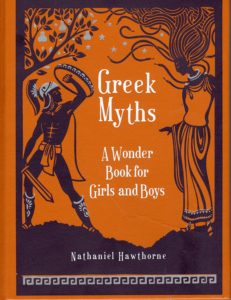Book Review: Greek Myths: A Wonder Book for Girls and Boys by Nathaniel Hawthorne
Tanglewood is a large country house out in the Berkshires which is owned by the Pringle family. They have a great many relatives with young children who often come visiting, and it frequently falls to their sole teenage relative, Eustace Bright, to entertain the younglings. It’s a good thing that young Mr. Bright knows many fascinating stories, and delights in the telling of them! Through the year, he regales his audience with tales of Greek mythology.
Nathaniel Hawthorne is one of the great American writers, creating The Scarlet Letter among other fine books, and was part of the Romantic and Gothic movements in literature. As seen in the introduction to this volume, he was also a firm believer in the right of writers to adapt and modernize stories in the public domain to match the needs of a new audience.
So it is that Eustace Bright feels free to switch details up, omit large sections and invent new plot points or characterization as he tells six stories from the Greek myth cycles. Covered in this volume are: Perseus & Medusa (which was also covered in The Blue Fairy Book which I have previously reviewed); King Midas and the Golden Touch; Pandora’s Box (lots of liberties taken here); Hercules and the Three Golden Apples; Philemon & Baucis; and Bellerophon & Pegasus. Introductions and postludes detail how each story comes to be told and the children’s reactions.
Mr. Hawthorne has some fun with his characters–Eustace has the sympathy of the narrator, but we are reminded from time to time that he is, after all, just a very bright teenager. The words “sophomoric erudition” are used, and Eustace has a fourth wall-breaking speech in which he admits that Hawthorne could in fact rewrite him and all his relatives at will. The member of the child audience who gets the most development is Primrose, a saucy thirteen year old lass who pokes fun at her older cousin’s self-importance even as she clamors for more of his stories.
The writing is lively and often humorous, but the “modernization” of the Greek myths ironically makes the telling seem old-fashioned. On the other hand, modern children might find the sections set in “the present day” more alien than the familiar stories of myth. There are also many fine illustrations by Walter Crane, including several color plates–sensitive parents should know that there’s some artistic nudity. And though some of the ickier aspects of Greek mythology are glossed over or omitted, there’s still plenty of violence.
The edition I have is a Barnes & Noble reprint; unlike The Blue Fairy Book it seems not to have been shortened. It’s a handsome book that should withstand being read by children.
Recommended for parents who want to introduce their children to relatively child-safe tellings of Greek mythology. I would suggest reading it with your children the first go-round to explain the setting of the frame story and help with some archaic words.


Hi Scott,
This looks like a book I might like to read. I think that there is much to be learned from the Greek myths and it is fun to see them with a modern slant.
Or in this case, a “modern” slant; it’s very much a product of its time.